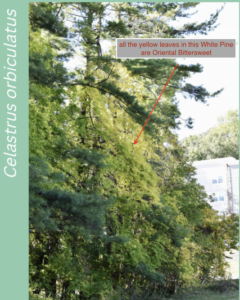Help Eradicate Oriental Bittersweet This Fall
go.ncsu.edu/readext?888587
en Español / em Português
El inglés es el idioma de control de esta página. En la medida en que haya algún conflicto entre la traducción al inglés y la traducción, el inglés prevalece.
Al hacer clic en el enlace de traducción se activa un servicio de traducción gratuito para convertir la página al español. Al igual que con cualquier traducción por Internet, la conversión no es sensible al contexto y puede que no traduzca el texto en su significado original. NC State Extension no garantiza la exactitud del texto traducido. Por favor, tenga en cuenta que algunas aplicaciones y/o servicios pueden no funcionar como se espera cuando se traducen.
Português
Inglês é o idioma de controle desta página. Na medida que haja algum conflito entre o texto original em Inglês e a tradução, o Inglês prevalece.
Ao clicar no link de tradução, um serviço gratuito de tradução será ativado para converter a página para o Português. Como em qualquer tradução pela internet, a conversão não é sensivel ao contexto e pode não ocorrer a tradução para o significado orginal. O serviço de Extensão da Carolina do Norte (NC State Extension) não garante a exatidão do texto traduzido. Por favor, observe que algumas funções ou serviços podem não funcionar como esperado após a tradução.
English
English is the controlling language of this page. To the extent there is any conflict between the English text and the translation, English controls.
Clicking on the translation link activates a free translation service to convert the page to Spanish. As with any Internet translation, the conversion is not context-sensitive and may not translate the text to its original meaning. NC State Extension does not guarantee the accuracy of the translated text. Please note that some applications and/or services may not function as expected when translated.
Collapse ▲ Did you know that a lot of invasive plant species we now want to eradicate from our yards, gardens, and forests were actually introduced to North America in the nursery trade? That’s right–they were brought here on purpose by plant sellers who were blissfully unaware of how future gardeners and nature lovers would curse them!
Did you know that a lot of invasive plant species we now want to eradicate from our yards, gardens, and forests were actually introduced to North America in the nursery trade? That’s right–they were brought here on purpose by plant sellers who were blissfully unaware of how future gardeners and nature lovers would curse them!
Oriental bittersweet (Celastrus orbiculatus) is one of these plants. While nobody is 100% sure how it got here from Asia, the Harvard Arboretum thinks it was introduced in the late 1800s by a nursery in New York state. It is still sold in the nursery trade today. Now, it grows everywhere, and here’s why that’s bad.
Oriental bittersweet is a woody vine that you often see at the edge of forests or roadsides. It can grow in dense thickets and high up trees, strangling them and shading the ground so that native plants can’t grow. It can grow as high as the trees it climbs and the vines can reach up to ten inches in diameter. It has male and female plants, and the small fruits are prolific and easily spread by birds. It kills trees and is slowly wiping out the native bittersweet vine through hybridization.
Eradicating Oriental bittersweet requires persistence, usually over several growing seasons. For small patches, hand pulling can work, but you’ll need to keep an eye on the area to pull up any stems that sprout the following season. For more advanced patches, herbicides can be useful. Don’t pull large vines away from trees since that can cause more damage to the tree or pull dead branches down on your head. If you cut the vines, the top part will die and eventually fall away. “Window cutting,” where you cut the vine in two places to leave a gap, can help you keep track of which vines you’ve cut. If the vine has fruit on it, bag it up to keep it from spreading. Don’t buy or make wreaths from Oriental bittersweet–that is just another way to spread the seeds.
Invasive Plants and Your Forests
Oriental Bittersweet: A Patient Invader
American and Oriental Bittersweet Identification
Species Dataform and Scoresheet for Celastrus orbiculatus
Untangling the Twisted Tale of Oriental Bittersweet
PennState Extension – Oriental Bittersweet
Oriental bittersweet: An aggressive, invasive plant
Non-Native Invasive Plants: Oriental Bittersweet (Celastrus orbiculatus)
Invasive Plant Atlas – Oriental Bittersweet
Defeating a killer vine: Oriental bittersweet management (YouTube)




